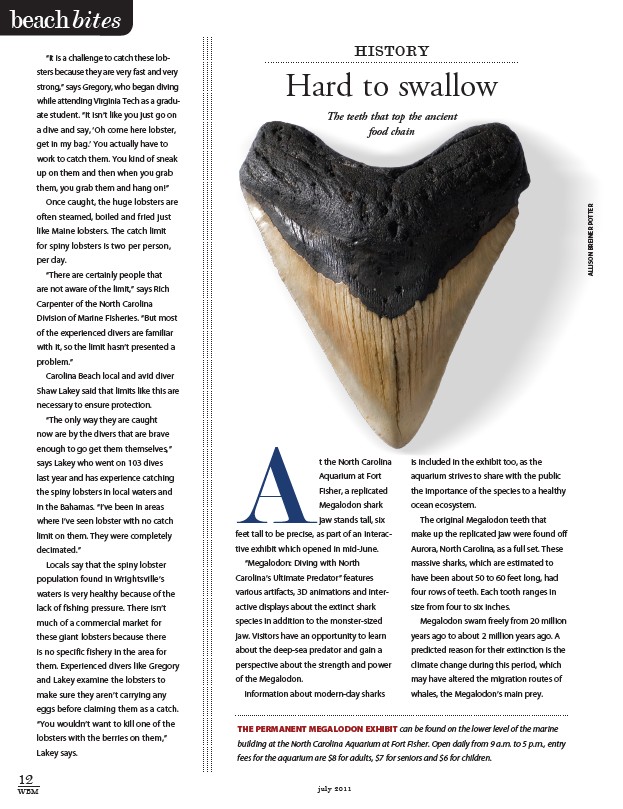
beachbites
At the North Carolina
Aquarium at Fort
Fisher, a replicated
Megalodon shark
jaw stands tall, six
feet tall to be precise, as part of an interactive
exhibit which opened in mid-June.
“Megalodon: Diving with North
Carolina’s Ultimate Predator” features
various artifacts, 3D animations and interactive
displays about the extinct shark
species in addition to the monster-sized
jaw. Visitors have an opportunity to learn
about the deep-sea predator and gain a
perspective about the strength and power
of the Megalodon.
Information about modern-day sharks
12
WBM july 2011
is included in the exhibit too, as the
aquarium strives to share with the public
the importance of the species to a healthy
ocean ecosystem.
The original Megalodon teeth that
make up the replicated jaw were found off
Aurora, North Carolina, as a full set. These
massive sharks, which are estimated to
have been about 50 to 60 feet long, had
four rows of teeth. Each tooth ranges in
size from four to six inches.
Megalodon swam freely from 20 million
years ago to about 2 million years ago. A
predicted reason for their extinction is the
climate change during this period, which
may have altered the migration routes of
whales, the Megalodon’s main prey.
“It is a challenge to catch these lobsters
because they are very fast and very
strong,” says Gregory, who began diving
while attending Virginia Tech as a graduate
student. “It isn’t like you just go on
a dive and say, ‘Oh come here lobster,
get in my bag.’ You actually have to
work to catch them. You kind of sneak
up on them and then when you grab
them, you grab them and hang on!”
Once caught, the huge lobsters are
often steamed, boiled and fried just
like Maine lobsters. The catch limit
for spiny lobsters is two per person,
per day.
“There are certainly people that
are not aware of the limit,” says Rich
Carpenter of the North Carolina
Division of Marine Fisheries. “But most
of the experienced divers are familiar
with it, so the limit hasn’t presented a
problem.”
Carolina Beach local and avid diver
Shaw Lakey said that limits like this are
necessary to ensure protection.
“The only way they are caught
now are by the divers that are brave
enough to go get them themselves,”
says Lakey who went on 103 dives
last year and has experience catching
the spiny lobsters in local waters and
in the Bahamas. “I’ve been in areas
where I’ve seen lobster with no catch
limit on them. They were completely
decimated.”
Locals say that the spiny lobster
population found in Wrightsville’s
waters is very healthy because of the
lack of fishing pressure. There isn’t
much of a commercial market for
these giant lobsters because there
is no specific fishery in the area for
them. Experienced divers like Gregory
and Lakey examine the lobsters to
make sure they aren’t carrying any
eggs before claiming them as a catch.
“You wouldn’t want to kill one of the
lobsters with the berries on them,”
Lakey says.
history
Hard to swallow
The teeth that top the ancient
food chain
Allison Breiner Potter
The permanent Megalodon exhibit can be found on the lower level of the marine
building at the North Carolina Aquarium at Fort Fisher. Open daily from 9 a.m. to 5 p.m., entry
fees for the aquarium are $8 for adults, $7 for seniors and $6 for children.